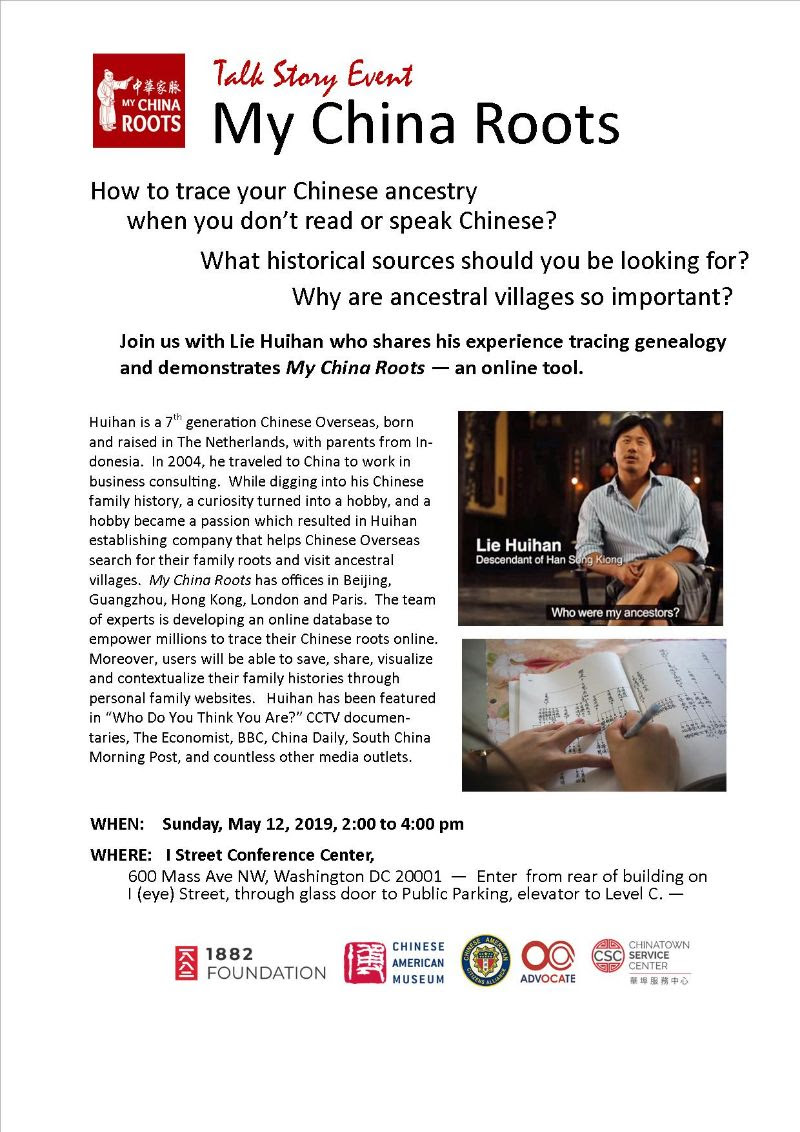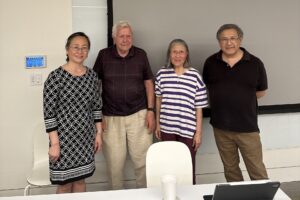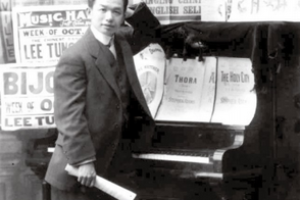Introduction
On May 12th, the 1882 Foundation hosted its monthly Talk Story event with Lie Huihan. Huihan is the founder of My China Roots, a Beijing-based company helping people find their ancestral history. The 1882 Foundation’s Executive Director Ted Gong kicked off the event by explaining his own ancestral history, which he learned about using the Chinese Family History Group of Southern California’s publication A Guide for Researching Your Chinese Family History.
Chinese family history is recorded in a jiapu/zupu, or genealogy book. Jiapu (家谱) and zupu (族谱) are technically different, as jiapu means “family book” and zupu means “clan book.” However, the two terms are used interchangeably. Jiapu come in all shapes and sizes. Some jiapu record only sons. Some include daughters. Jiapu can contain achievements, migration history, guidelines, moral codes, and generation poems. One achievement that was a source of great pride was passing examinations. A generation poem is a poem that some families adopt. Each consecutive character serves as the generation name for each consecutive generation. Everyone in the same generation shares this character in their name. A three character Chinese name includes the surname or family name, the generation name, and the personal name.

Ted’s jiapu starts with a Confucian analect on the importance of funeral rites. It begins in 2255 BC and travels through the dynasties. Like standard jiapus, it is organized by generations. It records marriages, sons, and a brief biography highlighting important events or awards. His jiapu includes a long narrative explaining that during the Warring States Period, the ancestral village was destroyed. The family then crossed the Nanling Mountains into Guangdong. The Nanling Mountains serve as a linguistic and cultural divide, so at that point, Ted’s family became Cantonese. Events can be precisely dated in Ted’s jiapu using the era system. In 1949, someone copied the jiapu and took it to Taiwan. The year 1949 is significant because of the Chinese Communist Revolution. Many jiapu were written on the walls of family village temples. When the Communists began to tear down temples and destroy records, people frantically copied down their jiapu on paper. Ted’s jiapu also includes a graph of the number of households that lived in the village in each generation starting from the first ancestor, or “first dragon.” The number dropped whenever there were disturbances, including his family’s immigration to the United States. Though his family is now in the US, Ted still continues the tradition of funeral rites that his jiapu emphasized. During the Cultural Revolution, graveyards were dug up and turned into productive lands. But afterwards, villages maintained ancestral graves again. Ted went back to China with his father to perform the annual rites. Even though they doubted the graves marked the exact place their ancestors rest, they were happy to have a place to carry on tradition.
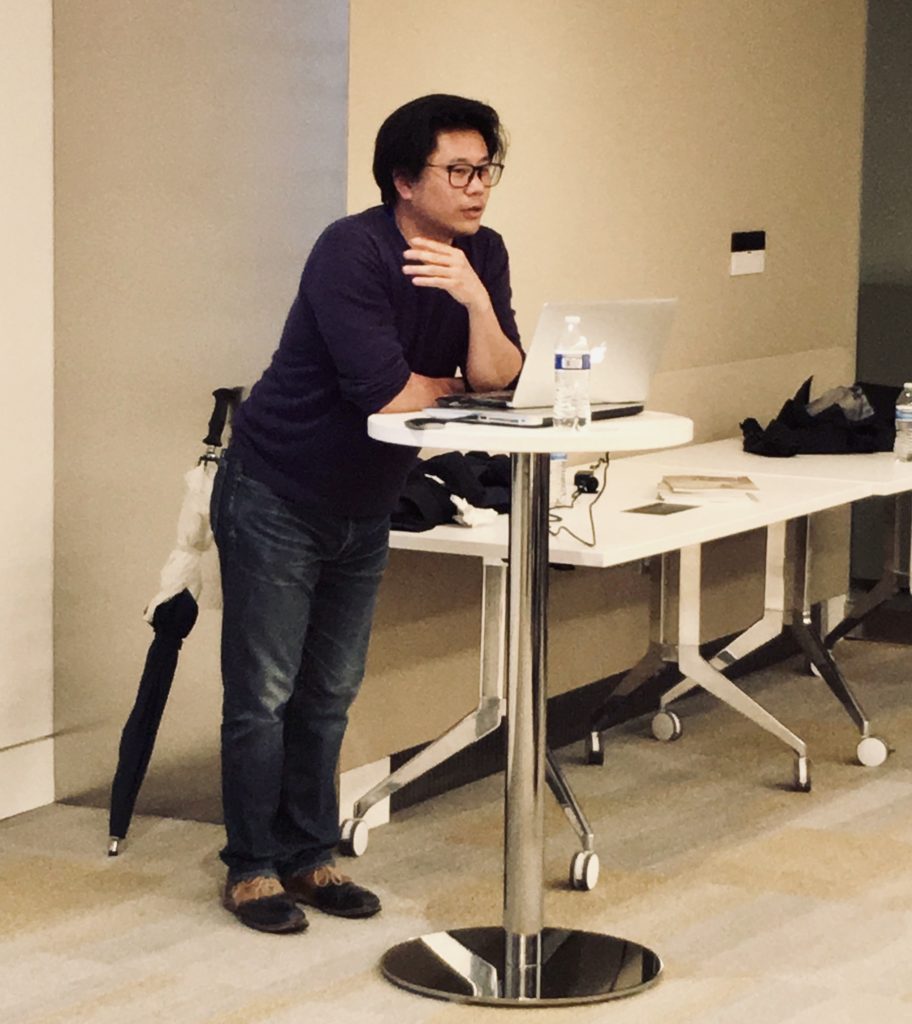
When guest speaker Lie Huihan arrived, he asked for a show of hands for who has visited their ancestral village in China. About half of the room raised their hands. When he then asked who could read Chinese, much fewer hands were up. Huihan’s company focuses on this disconnect– how can people find their family history when they do not speak Chinese? Huihan is from the Netherlands. Six generations ago, his family left Fujian for Indonesia, which was a Dutch colony at the time, so even his great grandparents could not speak Chinese. As a child, he was always interested in hearing stories about his family in Indonesia, but he wanted to learn more and trace his history back to China. He wanted to go to China, but he couldn’t speak a word of Chinese. Eventually, he took a leap of faith and just moved to China. When he started digging into his family history, he was profoundly impacted by this feeling of being connected to himself. Huihan knew that he is not the only overseas Chinese, he is not the only one who is curious. He founded My China Roots to help others like him.
Jiapu Research
The Chinese character “jia” (家) encapsulates the concepts of family, home, ancestral place, and identity. This reflects how in the West, the government or libraries maintain historical sources. In China, families maintain history. When researching Chinese family history, there are a number of obstacles such as the language gap, cultural barriers, geographic distance, and the false assumption that all historical sources are lost. While the Cultural Revolution destroyed many jiapu, many still exist, especially in places further away from Beijing. Additionally, in recent years there has been a resurgence of clans. People in the same clan come together and edit jiapu. So while there are resources, the main problem is that they are scattered. My China Roots assembles the scattered resources into a complete package.
How does someone start searching? First, they need the name of the home village, town, or county. The lowest administrative level is preferred. One obstacle to finding the ancestral village is that historical names and jurisdictions have changed. Another challenge is that it is difficult to convert a romanized name back into Chinese characters. One romanization could represent multiple Chinese characters, and one Chinese character has many different romanizations. Next, they need the names of the ancestors who left China, preferably in Chinese characters, as that is what will be written in the jiapu. Again, the same challenge with romanizations presents itself. Dialect romanizations and name changes based on the country later settled in are further complications. The 1882 Foundation’s Curriculum and Education Director Ting Yi Oei shared that even within his own family, there are many different romanizations of his surname 黄. In addition, people will use multiple names throughout their life– nicknames, milknames, and posthumous names– which will not match up with the name in the jiapu.
So where is this information? There are free general databases, but most genealogical firms target people with European or African American ancestry. Instead, Huihan encourages people to rely on oral histories and ask their relatives for as many details as possible. Tombstones and passports contain physical traces of names and places. For the Qingming Festival, or Tomb Sweeping Day, the ancestor needs to have the correct name and village on the gravestone in order for their descendants to make a petition to the gods for them. Thus, gravestones use Chinese characters instead of romanizations or paper names. However, a member from the audience said that because of an immigration scare, his family replaced tombstones containing Chinese names to include only paper names.
When people think they’ve found their village, what should they do? The first step is to find the contemporary name and location. Chinese government bureaus will assist with this. Then, all that’s left to do is to go and visit! Huihanh suggests that once in the village, people should bring pictures of ancestors and ask elders if they recognize anyone. People should also ask to see jiapu, wooden tablets, family houses, and graves. Bringing different sources together creates a larger comprehensive view of family history.
My China Roots
My China Roots offers three services. The first is a free online database. The demo is online now. People can search their romanized surname and find characters that have historically corresponded. My China Roots provides family history clues in what dialect and countries that romanization is typically located in. Once someone has found their Chinese character surname, they can see what jiapus are in the database and filter by ancestral village. My China Roots has acquired 2500 jiapus so far, focusing in the areas of Guangdong and Fujian that have an extensive history of immigration. The second step is to index all the jiapu and make the database searchable using OCR (optical character recognition). The search engine should be available in a year and a half. In the future, the database will be able to convert between simplified and traditional Chinese. People will be able to search by generation name and submit photos of their village for others to see.
My China Roots’ second service is a family website to expand on database information. The family website is subject to an annual subscription fee. The website provides visualization tools, such as timelines, maps, and family trees. Jiapu provide a personal history but no context. The timeline includes context sourced from local encyclopedias and global events such as the 1882 Exclusion Act. Using the timeline, people are able to follow their ancestors’ stories. The website’s map services use Google Maps as a framework. The map shows the village within a county or town where the majority of families share someone’s surname. It also shows where someone’s relatives are now, so they could connect with their cousin in Sydney, for example. People can create a family tree on the website and invite relatives to add family members or pictures.
My China Roots offers a customized service for those who want to go beyond the database and website. The company will go to the ancestral village, take pictures, interview people, and package all the information into a translated report. Villagers are happy to give information, as they want people to get in touch. Someone in the audience used the service last year, and they were able to meet their cousin. This shows how My China Roots is different from genetic testing platforms such as WeGene. WeGene gives an ethnicity breakdown but does not offer relative matching.
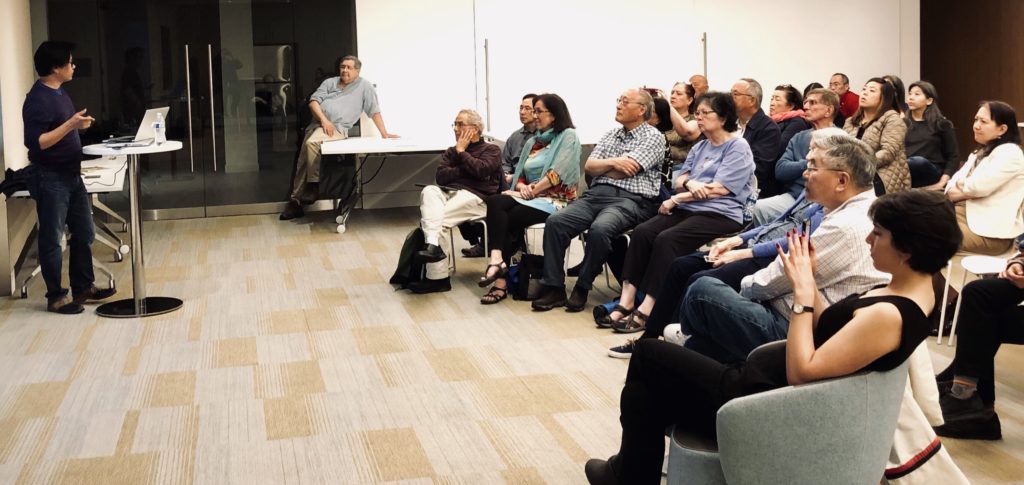
Special Cases
In cases of adoption, databases are not enough to find birth families. Usually, My China Roots will have to go back to the village for oral histories. An audience member shared that her father was adopted and rumored to be a stolen Hakka baby, and she asked how to research that history. Huihan responded that the Hakka are very proud of their identity and maintain extensive jiapu, so his name may be recorded. Hakka were often at war with local Cantonese groups– her father may come from a Romeo and Juliet story. Ted shared an interesting Hakka tradition he learned about while working in Guangzhong. Because Hakka moved around, they relied on the relationship with other Hakka families. Thus, they had a custom where the eldest son would be adopted to another family, whose eldest son would also be adopted out, and so on. This sociologically reinforces the Hakka group identity. Huihan also shared a fascinating Hakka case. Someone who was not Hakka had a jiapu with clear Hakka migration patterns. Huihan solved the puzzle, figuring out that their family’s jiapu was destroyed, so they adopted a Hakka family’s jiapu with the same surname.
Next Steps
An audience member asked why My China Roots does not provide services for Northern Chinese. She was concerned since the Cultural Revolution disproportionately wiped out Northern jiapu. Huihan replied that My China Roots is focused on Southern China simply because there is greater demand. Although immigration was historically forbidden, rules were less stringently enforced further away from the administrative center. Therefore, Southern China has had more immigration. Huihan plans to expand My China Roots to Northerners, but it will take a few more years.
Watch the full recording of this Talk Story here. The next Talk Story is on June 30th, with musicologist Eric Hung. Hope to see you there!

